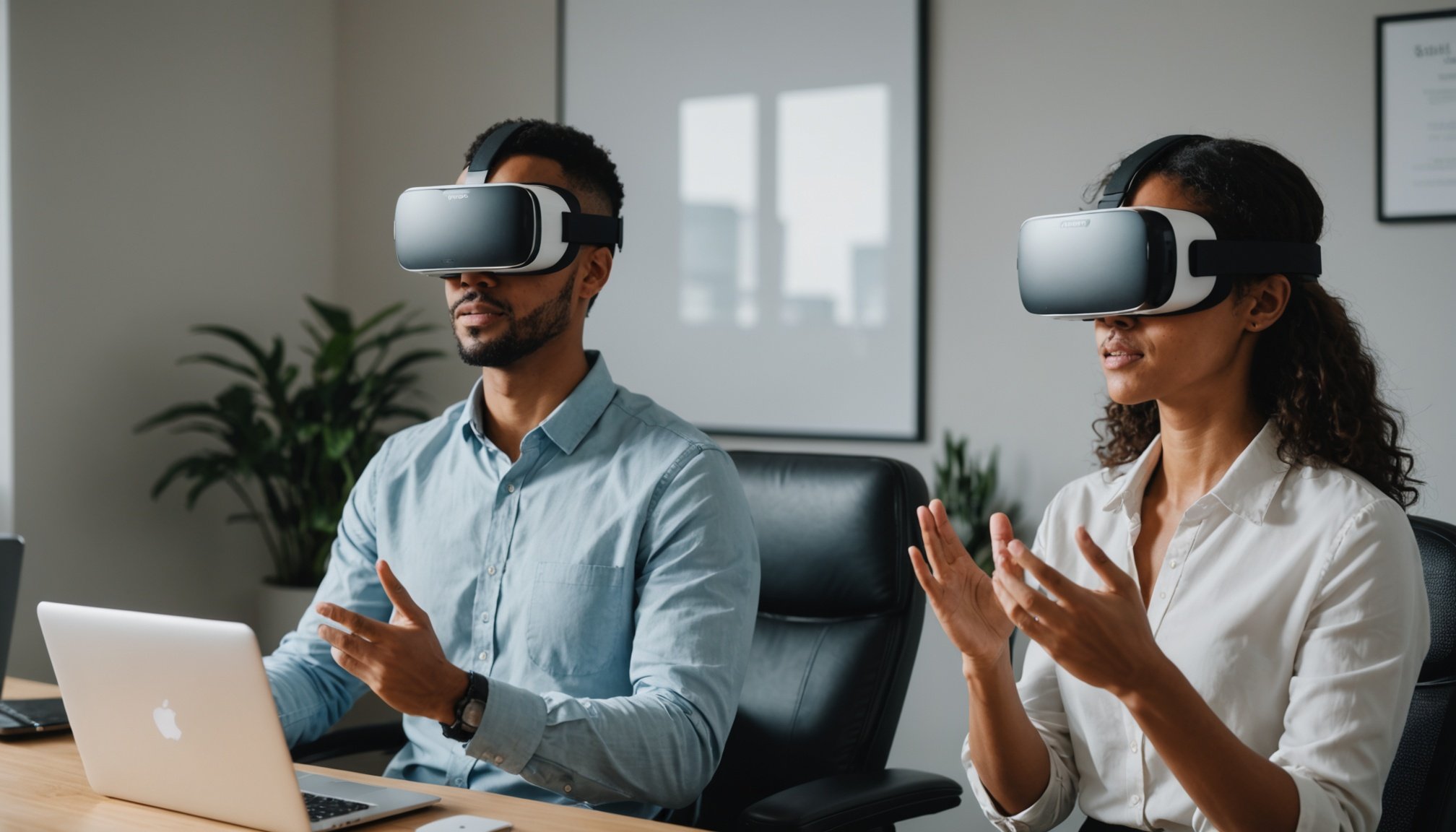Overview of Virtual Reality Mindfulness Training
Virtual Reality (VR) has become an innovative tool in the field of mindfulness training, offering a unique approach to stress reduction. VR mindfulness training immerses users in a virtual environment that encourages mindfulness practices, such as meditation and deep breathing. The main purpose is to help individuals manage stress effectively and improve overall mental health.
Intersection of Technology and Mental Health
The integration of technology with mental health practices has seen significant growth, especially within modern work environments. VR mindfulness training provides employees with on-demand access to a variety of serene and guided meditation experiences, directly addressing the hustle of the contemporary workplace. Using VR, individuals can virtually transport themselves to peaceful locations, supporting relaxation and focus, and enhancing their overall sense of well-being.
Also to discover : Exploring the Connection: Can Virtual Learning Boost Teenagers” Physical Activity Levels?
Applications in the Workplace
Incorporating VR mindfulness training in the workplace addresses the pressing need for mental health resources. It offers tailored sessions that can boost employee engagement, reduce stress levels, and potentially improve productivity. With the rapid evolution of workplace demands, this blend of tech and mindfulness becomes an indispensable resource. VR delivers a personal, interactive, and flexible way of practicing mindfulness, making it an attractive solution for stress management in professional settings.
Scientific Evidence Supporting VR Mindfulness Training
Virtual Reality (VR) mindfulness training is gaining traction as a tool for stress management. Numerous research studies have evaluated its effectiveness, offering valuable insights into its benefits.
Also to see : Unlocking the Perks: How a Gluten-Free Diet Can Enhance Life for Those with Non-Celiac Gluten Sensitivity
Overview of Key Research Findings
One pivotal study examined the impact of VR mindfulness on stress and cognitive function. Participants using VR reported significant reductions in stress levels. The immersive nature of VR appears to enhance the mindfulness experience, promoting relaxation and focus.
Meta-analyses on Mindfulness and VR
Meta-analysis consolidates findings from multiple research studies and highlights VR’s potential in mindfulness practices. These analyses indicate improved outcomes in stress reduction compared to traditional mindfulness methods, suggesting that VR may offer an engaging alternative with similar effectiveness.
Longitudinal Studies on Stress Reduction
Longitudinal studies have further contributed to understanding the effectiveness of VR mindfulness for stress management. Over extended periods, participants showed enduring benefits, with reduced stress levels and enhanced cognitive function. However, some critiques point to limitations in sample diversity and scalability. It is crucial to address these concerns to fully harness VR’s potential in mindfulness interventions.
Case Studies Demonstrating Effectiveness
The integration of VR mindfulness training in workplaces has been transformative for high-profile companies. Across industries, organizations have embraced real-world applications to enhance employee well-being. Let’s delve into some notable examples.
High-Profile Companies Utilizing VR Training
Companies like Walmart, Accenture, and Boeing have incorporated VR training into their workforce development strategies. These industry leaders have seen tangible benefits in employee preparedness and satisfaction. Walmart’s use of VR for employee onboarding has specifically improved retention rates and reduced training time.
Employee Feedback and Results
Employee feedback indicates a significant positive shift in their daily experiences. Workers report feeling more focused and less stressed, thanks to VR mindfulness programs. For example, participants from Accenture noted increased job satisfaction and a clearer sense of work-life balance. The immersive nature of VR allows employees to develop mindfulness skills effectively, thereby enhancing their overall performance.
Metrics for Measuring Success
Evaluating the success of VR training involves analysing specific metrics and KPIs. Companies track changes in productivity, reduced absenteeism, and improved employee well-being. For instance, Boeing’s metrics include enhanced project delivery times and fewer errors in manufacturing processes. These quantitative measures help in assessing the substantial return on investment in VR mindfulness training.
Practical Implementation Strategies for Organizations
Embedding VR mindfulness training into an organization can transform workplace culture and enhance employee well-being. Here, we explore a structured approach for effective adoption and integration.
Steps for Integrating VR Mindfulness Training
- Assessment: Begin with a needs assessment to identify the specific stressors your employees face. Understanding these will help tailor the mindfulness content.
- Selection: Choose VR technology and software aligning with your organization’s goals and budget.
- Pilot Program: Initiate a small-scale pilot to gather feedback and fine-tune the program for larger-scale implementation.
- Evaluation: Use metrics like employee well-being surveys and productivity levels to evaluate the effectiveness of the program.
Training Employees and Management
It’s crucial to train both employees and management on how to utilize VR for mindfulness. Provide workplace culture workshops that educate about VR equipment and its benefits. Train managers to encourage participation, creating a supportive environment. Continuous education ensures sustained engagement and avoids potential well-being issues.
Addressing Challenges and Concerns
Resistance to change is common. To mitigate this, communicate the benefits of VR mindfulness clearly. Address employee well-being concerns by ensuring all sessions maintain privacy and data protection. Provide technical support to resolve issues quickly and keep the process seamless. Enhance adoption by sharing success stories and testimonials from peers within the workplace culture context.
Overall Impact on Workplace Culture
Workplace culture significantly influences employee satisfaction and productivity. Introducing VR mindfulness training can potentially transform this environment by enhancing employee engagement and overall well-being. Through immersive experiences, such training enables employees to decompress, reducing stress levels substantially. As individuals engage with these digital mindfulness sessions, there’s an observable increase in workplace empathy and communication.
This shift supports healthier relationships among colleagues, which in turn, cultivates a more harmonious work atmosphere. By offering tools that assist in mental clarity and emotional intelligence, VR mindfulness training addresses well-being directly, promoting a supportive environment where employees feel valued and understood. This not only aids in their everyday interactions but significantly impacts employee retention as well.
Long-term exposure to such training can lead to a sustained boost in productivity. Employees are less likely to burn out and more inclined to contribute positively when their mental health is prioritized. Consequently, companies investing in VR mindfulness are likely to see enhanced success through improved employee morale and reduced turnover. Thus, the integration of mindful technology into daily routines presents a forward-thinking approach to fostering a vibrant, supportive, and effective workplace culture.
Overview of Virtual Reality Mindfulness Training
Virtual Reality (VR) mindfulness training has emerged as an innovative approach to enhance mental health and promote workplace wellness. This method integrates traditional mindfulness techniques with immersive VR technology, making the practice more engaging and accessible. Mindfulness in VR allows users to experience guided meditations or stress reduction exercises in virtual environments, thereby enabling a deeper focus and heightened sense of presence.
Historically, mindfulness practices have been rooted in ancient traditions, aiming to promote self-awareness and emotional balance. However, the introduction of VR has revolutionised these practices. With advancements in technology, the integration of VR in mindfulness training has gained momentum, evolving from experimental concepts to practical applications. This evolution is particularly evident in the workplace wellness initiatives currently trending. Companies are increasingly adopting VR mindfulness practices to bolster employee mental health, offering a novel solution to combat stress and improve productivity.
The significance of VR mindfulness training lies in its potential to transform mental health paradigms. By allowing individuals to disengage from daily stressors and immerse themselves in calming virtual scenes, this approach offers promising benefits. As VR technology continues to evolve, the impact on workplace wellness and mental health is expected to expand, making it a cornerstone of modern wellness strategies.
Implementation of VR Mindfulness in Workplaces
Incorporating VR implementation into workplace strategies can significantly enhance employee well-being. To effectively integrate VR mindfulness training into the workplace, organisations need to follow certain steps. Initially, it is crucial to identify the specific mindfulness needs and goals within the company. This helps to tailor the VR mindfulness sessions accordingly, ensuring they address the actual stressors and psychological demands employees face.
Creating a supportive environment is essential for successful VR implementation. Employee training plays a vital role here. Providing hands-on sessions and tutorials helps employees become familiar with the VR technology and its benefits. This not only boosts acceptance but also encourages active participation. Furthermore, integrating feedback loops where employees can share their experiences and suggestions enhances the process and outcomes.
Regarding tools and technology, various VR platforms offer diverse experiences tailored to workplace scenarios. Companies might consider VR headsets with easy navigation and interactive interfaces to facilitate smooth training sessions. Additionally, incorporating mindfulness applications that complement the existing workplace wellness programmes ensures a holistic approach to employee training. In essence, successful VR implementation in workplaces hinges on strategic planning, clear communication, and supportive technologies to foster a mindful work environment.
Scientific Studies on Effectiveness of VR Mindfulness
Exploring the realm of research studies, a wealth of insights regarding the effectiveness of VR mindfulness continues to unfold. These investigations delve into how virtual reality technology enhances stress management techniques.
Overview of Key Research Findings
Several key research studies have identified how VR mindfulness significantly contributes to stress reduction and boosts overall well-being. Participants in various trials frequently report decreased anxiety levels, showcasing the technology’s potential therapeutic benefits.
Analyzing Data on Stress Reduction
Data analysis from these studies reveals substantial stress reduction and enhanced clarity among users. Metrics show a clear decrease in cortisol levels, highlighting the physiological impact of VR mindfulness. This biometric evidence strongly supports VR as a viable mental health tool.
Comparative Studies with Traditional Mindfulness Practices
When comparing VR with traditional mindfulness techniques, studies consistently underscore VR’s interactive and immersive advantages. These components lead to deeper engagement. Consequently, users often express a preference for VR due to its captivating nature and ease of accessibility. Furthermore, statistical evaluations consistently demonstrate increased stress reduction in VR users, with many experiencing not just short-term relaxation but also sustained emotional balance.
Testimonials and Case Studies
Understanding the impact of VR mindfulness interventions requires exploring real-world applications. By examining user experiences and insights derived from case studies, we can better comprehend the transformative potential of these technologies.
Collecting and Analysing Testimonials
One effective method involves gathering user experiences to evaluate how successfully VR mindfulness tools fulfill their roles. Collecting feedback offers qualitative insights into areas like user satisfaction and personal growth. For instance, users of a VR mindfulness app report increased relaxation and improved concentration.
Key Case Studies
Case studies provide crucial evidence supporting VR mindfulness applications’ effectiveness. In one notable case, a large corporation integrated VR mindfulness sessions, resulting in significant decreases in employee stress levels. Participants noted enhanced mood and productivity. Such examples affirm VR mindfulness’s potential to foster positive outcomes in various environments.
Employee Feedback and Organisational Benefits
Organisational feedback illustrates the long-term benefits VR mindfulness can offer. Employees consistently report improved morale and collaboration, often attributing these positive shifts to VR mindfulness initiatives. These testimonials highlight how immersive technologies positively shape workplace dynamics, enhancing overall team synergy.
Practical Tips for Integration
Integrating new practices into a workplace can be challenging. Here are some practical tips to streamline this process and boost employee engagement.
Firstly, encourage employee participation by involving them in decision-making. Conduct brainstorming sessions to gather diverse perspectives and ideas. This empowers employees and fosters a sense of ownership.
Secondly, implement integration strategies by using tools for measuring effectiveness. Develop key performance indicators (KPIs) to track progress and analyze what is working. Survey tools can collect feedback, providing valuable insights into employee satisfaction and areas for improvement.
Next, focus on ongoing support for employees. This can be achieved through follow-up training sessions after initial implementation. Regular updates help reinforce new practices and address any emerging issues promptly.
Strategies for Encouraging Employee Participation
- Build a communication plan to keep employees informed about integration milestones.
- Create a collaborative workspace where employees can share experiences and support each other.
Tools for Measuring Effectiveness and Feedback
- Employ software that facilitates continuous feedback loops for employees.
- Use A/B testing to compare different integration approaches for effectiveness.
These strategies and tools can enhance the integration process, ensuring it is smooth and efficient while maintaining high levels of employee engagement.
Challenges and Limitations of VR Mindfulness
Virtual Reality (VR) mindfulness offers promising benefits, yet it is not without its limitations and challenges. One of the most significant barriers to widespread adoption in the workplace is the technological demands. Employers must ensure they have the necessary equipment and infrastructure, which can be costly and cumbersome. Additionally, employees may face initial hesitations when embracing VR technology due to unfamiliarity.
Common concerns surrounding VR technology include potential discomfort from prolonged use, such as motion sickness or eye strain. These factors, alongside the learning curve associated with using VR devices, can deter engagement. Privacy and data security questions also arise, especially in settings where personal information may be processed or stored.
To overcome these barriers, tailored solutions must be implemented. Proper training and ergonomic design are essential to improve user experience and reduce physical discomfort. Employers should consider running sessions that gradually introduce VR technology, alongside offering regular breaks to mitigate motion sickness.
Furthermore, ensuring robust security protocols will address any privacy concerns. As VR technology continues to evolve, addressing these limitations is crucial to facilitating a successful integration into mindfulness practices at workplaces.
The Future of VR in Mental Health and Workplace Wellness
The integration of emerging technologies in mental health practices is reshaping workplaces globally. New trends, particularly virtual reality (VR) mindfulness tools, are at the forefront of these advancements. These tools provide immersive experiences designed to reduce stress and enhance productivity, making them invaluable for workplace wellness programs.
As we look ahead, the future trends in this area are promising. VR innovations are expected to evolve with more personalized mindfulness experiences. These could include tailored meditative environments that react to real-time biometric data, enhancing the user’s engagement and effectiveness of mental health interventions.
In terms of workplace wellness, companies play a pivotal role. They are increasingly seen as facilitators of mental health innovations. By investing in VR technologies and integrating them into employee wellness programs, companies can promote a healthier and more productive workforce. This proactive approach not only benefits employees but can also positively impact an organisation’s bottom line.
With these evolving technologies, the future of mental health management looks to be both innovative and transformative. Companies embracing these changes will likely lead the way in promoting employee well-being and setting new standards in workplace wellness.











